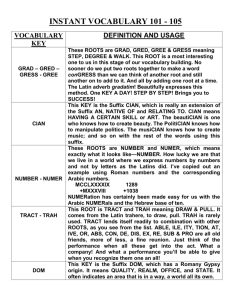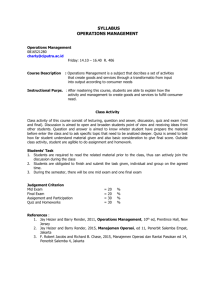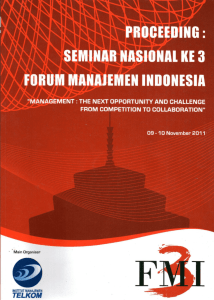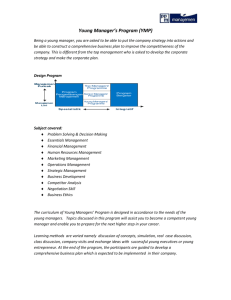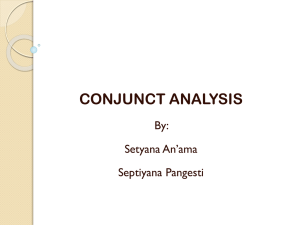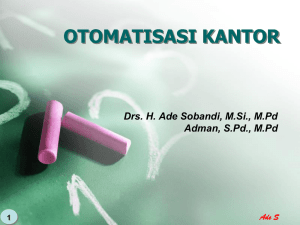PELELANGAN & DOKUMEN PENAWARAN
advertisement
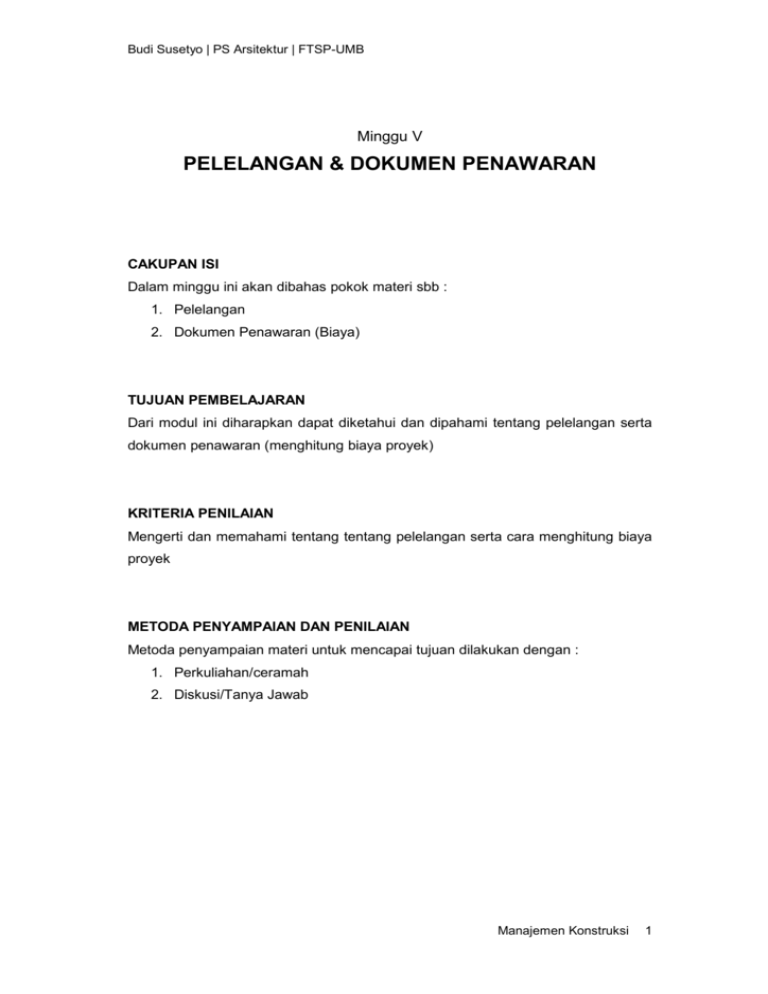
Budi Susetyo | PS Arsitektur | FTSP-UMB Minggu V PELELANGAN & DOKUMEN PENAWARAN CAKUPAN ISI Dalam minggu ini akan dibahas pokok materi sbb : 1. Pelelangan 2. Dokumen Penawaran (Biaya) TUJUAN PEMBELAJARAN Dari modul ini diharapkan dapat diketahui dan dipahami tentang pelelangan serta dokumen penawaran (menghitung biaya proyek) KRITERIA PENILAIAN Mengerti dan memahami tentang tentang pelelangan serta cara menghitung biaya proyek METODA PENYAMPAIAN DAN PENILAIAN Metoda penyampaian materi untuk mencapai tujuan dilakukan dengan : 1. Perkuliahan/ceramah 2. Diskusi/Tanya Jawab Manajemen Konstruksi 1 Budi Susetyo | PS Arsitektur | FTSP-UMB PELELANGAN Proses Pelelangan / Tender / Bid. Proyek Konstruksi Pelelangan proyek swasta dan pemerintah Pelelangan Proyek Pemerintah (Pelelangan Umum, terbatas dan penunjukkan ) Pelelangan pekerjaan perencanaan, Pelaksanaan dan Manajemen Konstruksi Proses Pelelangan versi Proyek Pemerintah : - Pengumuman - Pendaftaran - Undangan - Aanwijzing - Penawaran - Evaluasi - Usulan Pemenang - Penetapan Pemenang - Pengumuman - Penunjukan - Kontrak Persyaratan Pelelangan ( Administratif, Teknis dan Biaya ) Pustaka 1. Keppres No. 30 Tahun 2003 , tentang Pelelangan Proyek Pemerintah 2. Bacaan sejenis Format dokumen untuk pelelangan diperlihatkan pada halaman berikut. Manajemen Konstruksi 2 Budi Susetyo | PS Arsitektur | FTSP-UMB Contoh Pengumuman Pelelangan Pengumuman Pelelangan Terbatas Nomer :………………………. Kepala Kantor Dinas PU akan mengadakan pelelangan Terbatas pasca kualifikasi , Pekerjaan Rehabilitasi Bangunan Gedung Labolatorium luas 300 m2 dengan 2 lantai dan perkiraan nilai pekerjaan adalah Rp 3.400.000.000,Bagi Badan Usaha yang mempunyai SBU (lama) AP002 = gedung dan pabrik atau SBU (2007)=21005 dan mempunyai persyaratan sebagai perusahaan non kecil dan pernah melaksanakan pekerjaan renovasi bangunan gedung perkantoran dengan nilai akhir kontrak minimal Rp 1.700.000.000 serta mempunyai tenaga ahli S1 Arsitektur/Sipil dengan pengalaman minimum 2 tahun dipersilahkan mendaftarkan diri pada kantor Dinas PU Jln ………Propinsi Kaltim Pendaftaran dilakukan oleh Direktur Utama atau dikuasakan dengan kewajiban namanya tercamtum dalam akta pendirian atau perubahannya Calon peserta wajib membawa IUJK asli dan SBU asli Panitia lelang Manajemen Konstruksi 3 Budi Susetyo | PS Arsitektur | FTSP-UMB Contoh E-Procurement Menuju E-procurement maka digulirkan E-announcement pengadaan barang / jasa di Indonesia • • • • Tindak lanjut Peraturan Presiden no 8 tahun 2006 LPSE Nasional merupakan situs e-Procurement yang menyediakan jasa lelang secara online. Seluruh panitia lelang yang melakukan pengadaan barang /jasa dengan dana APBN/APBD wajib memasukkan informasinya pada LPSE Nasional Badan Usaha yang ingin mengikuti lelang di LPSE Nasional dengan terlebih dahulu mendaftar sebagai rekanan. E-procurement maka digulirkan E-announcement pengadaan barang / jasa di Indonesia dpat dilihat pada : 1.http://www.pengadaannasional-bappenas.go.id/eproc/app 2.http://www.pengadaannasional.depkominfo.go.id/ Manajemen Konstruksi 4 Budi Susetyo | PS Arsitektur | FTSP-UMB Kelas Kontraktor KUALIFIKASI KONTRAKTOR GRED 7 Badan Usaha 1 M sd tak terhingga B Badan Usaha 1 M sd 25 M GRED 6 M GRED 5 GRED 4 GRED 3 Badan Usaha 1 M sd 10 M Badan Usaha 0 sd 1 M Badan Usaha 0 sd 600 juta K GRED 2 GRED 1 Badan Usaha 0 sd 300 juta Orang Perseorangan 0 sd 100 juta Manajemen Konstruksi 5 Budi Susetyo | PS Arsitektur | FTSP-UMB Gred Kontraktor N0 KUALIFIKASI KEUANGAN = KB 1 GRED 1 Tidak ada 2 GRED 2 50 jt – 600 jt 3 GRED 3 100 jt – 800 jt 4 GRED 4 400 jt – 1000 jt 5 GRED 5 1 – 10 Milyar 6 GRED 6 3 – 25 Milyar 7 GRED 7 10 M – tak terbatas Kualifikasi Kontraktor – Persyaratan Teknis N0 KUALIFIKA PJT-Lama Persyaratan SI bekerja TENAGA TEKNIS - PJB 1 GRED 1 SKTK 2 GRED 2 SKTK- 2 thn 1 org / BU SKTK- 2thn 3 GRED 3 SKTK-5 thn 1 org / BU SKTK- 5 thn 4 GRED 4 SKTK-10 th 1 org / BU SKTK-10 th 5 GRED 5 SKA-2 thn 1 org / BID USAH SKA-2 thn 6 GRED 6 SKA-5 thn 1 org / BID USAH SKA-5thn 7 GRED 7 SKA-8 thn 1 org / BID USAH SKA-8 thn 1 org yg bersangkutan Manajemen Konstruksi 6 Budi Susetyo | PS Arsitektur | FTSP-UMB Kualifikasi Kontraktor – Pengalaman Pekerjaan N0 KUALIFIKASI PENGALAMAN SUB BIDANG= 7 THN 1 GRED 1 Harus punya SKTK dan pengalaman di sub bidang 2 GRED 2 Tanpa pengalaman 3 GRED 3 3 pekerjaan G2 min 400 juta 4 GRED 4 3 pekerjaan G3 min 800 juta 5 GRED 5 3 pekerjaan G4 min 2,5 milyar 6 GRED 6 3 pekerjaan G5 min 12 milyar 7 GRED 7 3 pekerjaan G6 min 32 milyar Manajemen Konstruksi 7 Budi Susetyo | PS Arsitektur | FTSP-UMB Bacaan Lanjut : Cost estimating in PM Posted by Civil Engineer In order to achieve accurate estimates in Project Management, cost estimating strategy is a must. This cost estimating strategy is developed based on a three-step process. These steps lead to a more accurate cost estimate by incorporating the knowledge gained during the design phase of the project combined with knowledge from previous projects. With the adoption of this strategy, a strategy explanation should be included in the Project Management Plan. Rough initial Estimates The Initial Rough Estimate is developed during the Initiating Phase and is based on the information provided in the high-level scope along with information from previous projects the project manager has been involved with or from similar projects they have heard about. This Initial Rough Estimate will be presented as a part of the Concept Proposal. Intermediate Estimates During the Planning Phase, the project requirements will be developed by the analyst and the project manager for the customer’s review and approval and will further clarify and define the project estimates. More details are provided to the project team to allow them to help the project manager with project estimates. A detailed project schedule is created by the project manager to provide duration and effort for each task, the assignment of resources for each task, and a complete and detailed cost estimate of the project effort. Final Detailed Project Estimate The detailed project designs are created allowing the project manager to refine some of the project tasks and add the estimation of costs such as hardware, software, and items such as test equipment or additional space for the project team. At this point, the initial estimates created for the Concept Proposal can be updated or replaced to reconcile the more accurate total project cost information. The new estimate is communicated to the project stakeholders. Manajemen Konstruksi 8 Budi Susetyo | PS Arsitektur | FTSP-UMB Construction Cost estimates Construction cost constitutes only a fraction, though a substantial fraction, of the total project cost. However, it is the part of the cost under the control of the construction project manager. The required levels of accuracy of construction cost estimates vary at different stages of project development, ranging from ball park figures in the early stage to fairly reliable figures for budget control prior to construction. Since design decisions made at the beginning stage of a project life cycle are more tentative than those made at a later stage, the cost estimates made at the earlier stage are expected to be less accurate. Generally, the accuracy of a cost estimate will reflect the information available at the time of estimation. Construction cost estimates may be viewed from different perspectives because of different institutional requirements. In spite of the many types of cost estimates used at different stages of a project, cost estimates can best be classified into three major categories according to their functions. A construction cost estimate serves one of the three basic functions: design, bid and control. For establishing the financing of a project, either a design estimate or a bid estimate is used. Manajemen Konstruksi 9 Budi Susetyo | PS Arsitektur | FTSP-UMB 1. Design Estimates For the owner or its designated design professionals, the types of cost estimates encountered run parallel with the planning and design as follows: * Screening estimates (or order of magnitude estimates) * Preliminary estimates (or conceptual estimates) * Detailed estimates (or definitive estimates) * Engineer’s estimates based on plans and specifications For each of these different estimates, the amount of design information available typically increases. 2. Bid Estimates For the contractor, a bid estimate submitted to the owner either for competitive bidding or negotiation consists of direct construction cost including field supervision, plus a markup to cover general overhead and profits. The direct cost of construction for bid estimates is usually derived from a combination of the following approaches. * Subcontractor quotations * Quantity takeoffs * Construction procedures. 3. Control Estimates For monitoring the project during construction, a control estimate is derived from available information to establish: * Budget estimate for financing * Budgeted cost after contracting but prior to construction * Estimated cost to completion during the progress of construction Manajemen Konstruksi 10 Budi Susetyo | PS Arsitektur | FTSP-UMB Construction Projects are defined by their scope, budget, and schedule Construction Projects are defined by their scope, budget, and schedule. Technorati Profile For example, an Agency is to undertake a project to design and build a new maintenance facility for its fleet of buses (scope), at an estimate of $30 million (preliminary budget) over a three-year period of construction (schedule). The schedule specifies a defined beginning and end. Projects go through a life cycle of phases between their beginnings and ends that forconstruction projects are typically: initiation, planning, design, construction, commissioning, and closeout. Scope: Each project is unique and must have a written requirements document that takes into consideration operational needs, level of service, regulatory requirements such as Americans with Disabilities Act, and quality of deliverables. The scope evolves as new information becomes available through the project life cycle. For example, in the early planning phases of the maintenance facility project, the scope is to have five service bays. Later, as the design progresses, the exact location and the type of service in each bay can be determined. Scope refinement should not be confused with scope creep. Scope creep occurs when the Agency determines part way through the project that operational projections now call for six rather than five service bays. Changing to six bays after the project is underway is a serious change in scope that could impact the budget (larger facility, more land, redesign) and delay the schedule (replan, redesign, longer construction). Scope Manajemen Konstruksi 11 Budi Susetyo | PS Arsitektur | FTSP-UMB refinement is a necessary process in the project life cycle while scope creep results from lack of clarity on the Agency’s requirements in the original scope for the needs, level of service, and level of quality for the deliverables. Schedule: All projects must have a definite beginning and end. The Agency’s Capital Improvement Plan (CIP) usually provides approximate dates for the beginning of a project and the end date when it is due to go into operation. Once there is a well-defined scope, the Agency needs to determine the time it will take to complete the project by developing the project schedule. Developing the schedule involves breaking down the work into manageable activities needed to accomplish the scope of each deliverable, estimating the duration of each activity, and placing them in a logical sequence. The result is a project schedule that tells you the expected duration of the project and the logical relationships between the activities, including activities on the “critical path,” that controls the end date. Budget: All projects are constrained by limited monetary funding resources. Consequently, every project needs a budget to initially define its funding requirement. The project manager develops the budget based on the cost estimates at the beginning of each project phase and refines it once there is better information defining the scope. Refining the budget occurs through studies and analysis in the design development process through the preliminary engineering phase. When Agencies try to fix the budget too early in the project life cycle, they are surprised by the significant increases in the budget over what was set forth in the CIP. The budget should not be fixed as baseline until after completion of the preliminary engineering phase. Please refer some other post for more specific about Scope, Budget and Schedule in Construction Project Management. Manajemen Konstruksi 12 Budi Susetyo | PS Arsitektur | FTSP-UMB Construction accidents Construction accidents are one of the most common work related personal injuries. Construction injuries may be the result of machinery failure involving fork lifts, cranes, front end loaders and any other piece of construction machinery found on the job site. They may also involve faulty safety equipment, falling debris, lack of proper training for construction workers, improperly assembled scaffolding, structural collapse, electrical fires, electrocution and a slew of other job site violations. Under the U.S. Department of Labor, The Occupational Safety and Health Administration (OSHA) must protect those who work in the construction industry. OSHA guarantees a certain level of safety for any construction worker who works on high risk job sites and is exposed to hazardous conditions. In addition, the State of Oregon protects construction workers under the Oregon’s Employer Liability Law. This law requires all construction companies engaged in dangerous work to take every necessary precaution in order to prevent worker injury on the job site. Construction is a dangerous profession and there are many hazards in the construction workplace. While these state and federal regulations are necessary, they offer only a small amount of comfort to construction workers and their families. In many cases, construction workers are victims of irresponsible employers and are exposed to unnecessary risk while at work. It is also common for third party members, such as contractors and subcontractors, to be present on the job site, creating hazardous and chaotic conditions for the workers. No matter what construction company you work for, it is the responsibility of the construction company to educate their workers on proper safety precautions and to Manajemen Konstruksi 13 Budi Susetyo | PS Arsitektur | FTSP-UMB make sure the job site meets all safety regulations. The Department of Labor and Industries examined construction injuries over a four year period. They found the following seven injuries to be the most common (they also accounted for 92 percent of all compensable claims): • Work-related musculoskeletal disorders of the neck, back and upper extremities • Workers struck by heavy machinery or falling objects • Workers pinned up against a wall by machinery or motor vehicles • Workers caught inside or underneath a piece of machinery • Slips or falls on ground level of the construction site • Falls from an elevated height of the construction site • General motor vehicle injuries If you or someone you know has been injured on a construction site, contact a personal injury lawyer to help you with your case. An experienced personal injury attorney will know how to deal with multiple insurance policies, identify all parties involved in the construction process and help you figure out who is responsible for the construction injury. Manajemen Konstruksi 14

